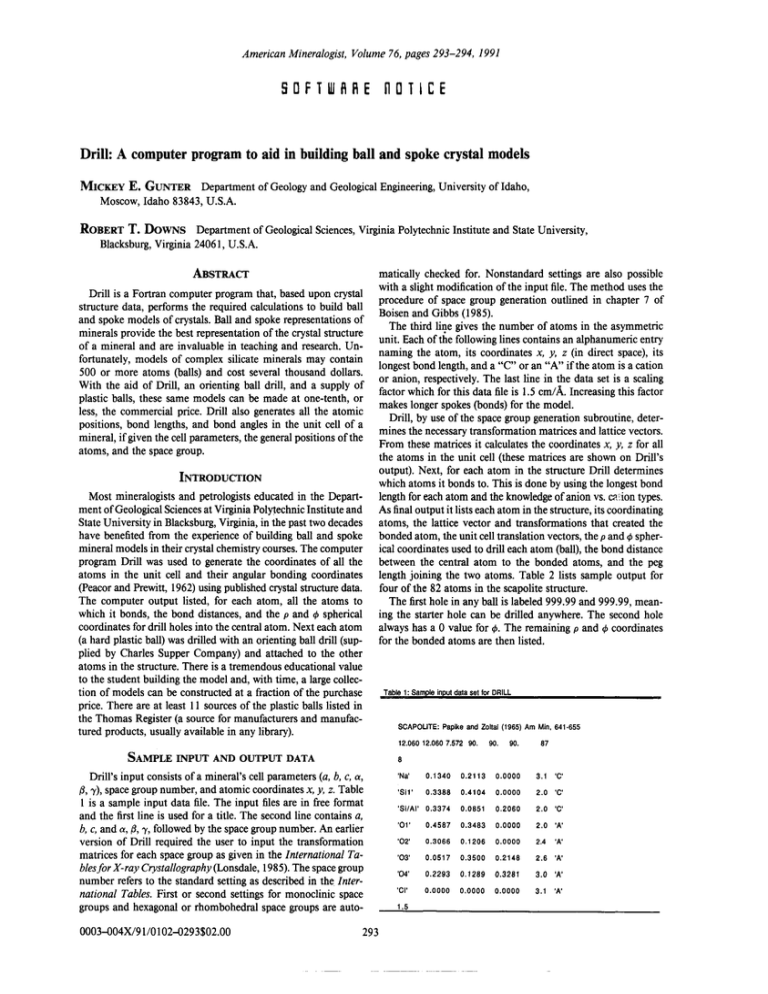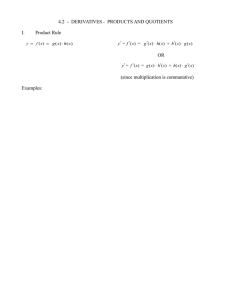SOFTWARE nOTICE Drill: A computer program to aid in building ball and...
advertisement

American Mineralogist. Volume 76, pages 293-294. 1991 SOFTWARE nOTICE Drill: A computer program to aid in building ball and spoke crystal models MICKEY E. GUNTER Department of Geology and Geological Engineering, University ofIdaho, Moscow, Idaho 83843, U.S.A. ROBERT T. DoWNS Department of Geological Sciences, Virginia Polytechnic Institute and State University, Blacksburg, Virginia 24061, U.S.A. matically checked for. Nonstandard settings are also possible with a slight modification of the input file. The method uses the procedure of space group generation outlined in chapter 7 of Boisen and Gibbs (1985). The third line gives the number of atoms in the asymmetric unit. Each of the following lines contains an alphanumeric entry naming the atom, its coordinates x. y, z (in direct space), its longest bond length, and a "c" or an "A" if the atom is a cation or anion, respectively. The last line in the data set is a scaling factor which for this data file is 1.5 cm/ A. Increasing this factor makes longer spokes (bonds) for the model. Drill, by use of the space group generation subroutine, determines the necessary transformation matrices and lattice vectors. From these matrices it calculates the coordinates x, y. z for all the atoms in the unit cell (these matrices are shown on Drill's output). Next, for each atom in the structure Drill determines which atoms it bonds to. This is done by using the longest bond length for each atom and the knowledge of anion vs. c,",'ion types. As final output it lists each atom in the structure, its coordinating atoms, the lattice vector and transformations that created the bonded atom, the unit cell translation vectors, the p and <I> spherical coordinates used to drill each atom (ball), the bond distance between the central atom to the bonded atoms, and the peg length joining the two atoms. Table 2 lists sample output for four of the 82 atoms in the scapolite structure. The first hole in any ball is labeled 999.99 and 999.99, meaning the starter hole can be drilled anywhere. The second hole always has a 0 value for <1>. The remaining p and <I>coordinates for the bonded atoms are then listed. ABSTRACT Drill is a Fortran computer program that, based upon crystal structure data, performs the required calculations to build ball and spoke models of crystals. Ball and spoke representations of minerals provide the best representation of the crystal structure of a mineral and are invaluable in teaching and research. Unfortunately, models of complex silicate minerals may contain 500 or more atoms (balls) and cost several thousand dollars. With the aid of Drill, an orienting ball drill, and a supply of plastic balls, these same models can be made at one-tenth, or less, the commercial price. Drill also generates all the atomic positions, bond lengths, and bond angles in the unit cell of a mineral, if given the cell parameters, the general positions of the atoms, and the space group. INTRODUCTION Most mineralogists and petrologists educated in the Department of Geological Sciences at Virginia Polytechnic Institute and State University in Blacksburg, Virginia, in the past two decades have benefited from the experience of building ball and spoke mineral models in their crystal chemistry courses. The computer program Drill was used to generate the coordinates of all the atoms in the unit cell and their angular bonding coordinates (peacor and Prewitt, 1962) using published crystal structure data. The computer output listed, for each atom, all the atoms to which it bonds, the bond distances, and the p and <I>spherical coordinates for drill holes into the central atom. Next each atom (a hard plastic ball) was drilled with an orienting ball drill (supplied by Charles Supper Company) and attached to the other atoms in the structure. There is a tremendous educational value to the student building the model and, with time, a large collection of models can be constructed at a fraction of the purchase price. There are at least 11 sources of the plastic balls listed in the Thomas Register (a source for manufacturers and manufactured products, usually available in any library). Table 1: Sample input data set for DRILL SCAPOLITE: Paplke and Zoltal (1965) Am Min. 641-655 12.060 12.060 7.572 90. SAMPLE INPUT AND OUTPUT DATA 102-0293$02.00 90. 87 8 Drill's input consists of a mineral's cell parameters (a. b, c, a, (3,)'), space group number, and atomic coordinates x, y. z. Table 1 is a sample input data file. The input files are in free format and the first line is used for a title. The second line contains a, b, c, and a, (3,)', followed by the space group number. An earlier version of Drill required the user to input the transformation matrices for each space group as given in the International Tablesfor X-ray Crystallography (Lonsdale, 1985). The space group number refers to the standard setting as described in the International Tables. First or second settings for monoclinic space groups and hexagonal or rhombohedral space groups are auto0003-o04X/91/0 90. 'Na' 0.1340 0.2113 0.0000 3.1 'SI1' 0.3388 0.4104 0.0000 2.0 'SI/AI' 0.3374 0.0851 0.2060 2.0 '01' 0.4587 0.3483 0.0000 2.0 '02' 0.3066 0.1206 0.0000 2.4 '03' 0.0517 0.3500 0.2148 2.6 '04' 0.2293 0.1289 0.3281 3.0 'CI' 0.0000 0.0000 0.0000 3.1 1.5 293 'C' 'C' 'C' 'A' 'A' 'A' 'A' 'A' 294 GUNTER AND DOWNS: DRILL, A CRYSTAL MODEL COMPUTER To run Drill the minimum Table 2: Sample section of DRILL's output Central T(x)T(y)T(z) Coordinating atom Na (1,1) 1 bond peg lenoth lenoth 2.351 2.5 .00 2.535 2.8 2.8 atoms PROGRAM hardware requirement for an MS- DOS computer is an 8088 processor with SI2K RAM; a math chip (e.g., an 8087 coprocessor) will greatly reduce calculation time. The minimum hardware requirement for the Macintosh family is a Mac Plus. (Drill may run on a 512K Mac but none were available for testing.) The program can be supplied on ei- 4102 (1,1) O. O. O. 999.99 4903 (1,1) O. O. O. 130.80 55 03 (1,4) O. 0.-1. 130.80 115.86 2.535 6504 (1,1) O. O. O. 59.46 320.02 2.912 3.4 ther S.2S-in. or 3.5-in. disks for MS-DOS computers or 3.5-in. 400K or 800K disks for the Macintosh computers. The program has been successfully tested on the following computer systems; after each configuration the number in parentheses represents 7104 (1,4 ) O. 0..1. 59.46 155.84 2.912 3.4 execution time for the data set in Table 1: IBM PC (63 min), 7404 (2,5) O. 0.-1. 78.61 85.69 2.851 3.3 Leading Edge Model D with an 8087 coprocessor (2 min and 53 s), IBM AT with an 80287 coprocessor (2 min and 34 s), Model 8004 (2,8) O. O. O. 78.61 30.17 2.851 3.3 70 IBM with an 80387 81 CI (1,1) O. O. O. 94.66 237.93 3.018 3.5 and 33 s), and a Mac IIcx (2 min and 42 s). (2,1 )-1. O. O. 999.99 999.99 1.583 1.4 .00 1.628 1.4 All versions of the program run in file is created with an editor or word The program prompts for both the upon execution. After execution the SI1 (2,3) 14 34 01 999.99 coprocessor (20 s), a Mac Plus (13 min batch mode. The input data processor as an ASCII file. input and output data files output file can be viewed, 3801 (2,3) O. O. O. 113.23 6704 (1,2) O. O. O. 109.30 121.09 1.610 1.4 77 04 (1,7) O. O. O. 109.30 238.91 1.610 1.4 9 SI1 (1,1) O. O. O. 999.99 999.99 1.628 1.4 13811 (1,3) 0, O. O. 156.77 .00 1.583 1.4 The authors wish to thank G.V. Gibbs for introducing them to the methods of building ball and spoke crystal models and 2Na (2,1 ) O. O. O. 999.99 999.99 3.018 3.5 4Na (2,2) O. O. O. 90.00 ,00 3.017 3.5 availability of a large collection of these models at Virginia Polytechnic Institute and State University has aided many students 6Na (2,3) O. O. O. 90.00 180.00 3.017 3.5 8Na (2,5) O. O. O. 180.00 999.99 3.018 3.5 either with an editor or word processing program, and printed if desired. ACKNOWLEDGMENTS 01 (1,1) 33 F.F. Foit for reviewing CI (2,1) 82 in their understandings thank the University port of this project. and improving of crystal chemistry. of Idaho Research REFERENCES HARDWARE REQUIREMENTS AND AVAILABILITY Drill was originally written for a mainftame computer in the 1960s. Since then it has been ported to the PC and completely rewritten. This new version of the program is much easier to use and is available for either MS-DOS or Macintosh computers. Execution time is a function of the complexity of the structure. The MS-DOS version was compiled with Microsoft The Macintosh version was compiled with Absoft Fortran Fortran 4.0. 2.4.' The M.E.G. wishes to Council for partial sup- CITED Boisen, M.B., Jr., and Gibbs, G.V. (1985) Mathematical crystallography. Mineralogical Society of America Reviews in Mineralogy, 15, 1-406. Lonsdale, K. (1985) International tables of X-ray crystallography, vol. 1 (3rd edition). Oordrecht, Holland. Papike, J.J., and Zoltai, T. (1965) The crystal structure of a marialite scapolite. American Mineralogist, 50, 641-655. Peacor, O.R., and Prewitt, C.T. (1962) Drilling coordinates for crystal structure models. The Review of Scientific Instruments, 33, no. 5, 550551. , Either version of Drill, along with sample data sets, is available from M.E. Gunter. Please send a blank disk and a selfaddressed mailer. the manuscript. MANuSCRIPT RECEIVED APRIL 26, 1990 MANUSCRIPT ACCEPTED NOVEMBER 16, 1990



